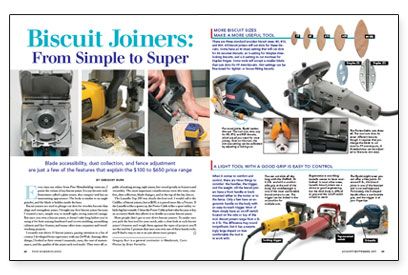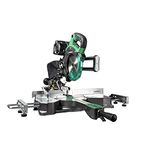Biscuit Joiners: From Simple to Super
Blade accessibility, dust collection, and fence adjustment are just a few features that explain the $100 to $650 price range.

Synopsis: There is no question why biscuit joiners are so useful. They increase the quality of almost any joint. The mystery with these tools is their price range. Why pay $650 for a biscuit joiner when you can make strong, tight joints with a $100 tool? A close look at 11 models shows that you get what you pay for in features and versatility. General contractor Gregory Burr chooses both the best overall biscuit joiner and the best value.
Every time my editor from Fine Homebuilding visits me, I praise the virtues of my biscuit joiner. It is my favorite tool. Sometimes called a plate joiner, this compact tool has an unassuming appearance: The body is similar to an angle grinder, and the blade is hidden inside the base.
Biscuit joiners are used to plunge-cut slots for wooden biscuits that align and strengthen joints. I bought my first biscuit joiner because I wanted a sure, simple way to install tight, strong mitered casings. But once you own a biscuit joiner, it doesn’t take long before you’re using it for butt-joining baseboard and crown molding, assembling cabinets and face frames, and many other trim-carpentry and woodworking projects.
I recently test-drove 11 biscuit joiners, paying attention to a list of criteria I developed from experience with my DeWalt. Among other things, I looked at their owner’s manuals, cases, the ease of maintenance, and the quality of the joints each tool made. They were all capable of making strong, tight joints, but varied greatly in features and versatility. The most important considerations were slot sizes, comfort, dust collection, blade changes, and at the top of the list, fences.
The Lamello Top 20S was clearly the best tool. I would call it the Cadillac of biscuit joiners, but at $650, it is priced more like a Ferrari. If the Lamello is like a sports car, the Porter-Cable is like a sport-utility vehicle: big but versatile. I chose the Porter-Cable as best value because it has an accessory blade that allows it to double as a mini-biscuit joiner.
Most people don’t get to test-drive biscuit joiners. To make sure you pick the best tool for your needs, take a close look at each biscuit joiner’s features and weigh them against the types of projects you’ll use the tool for. I promise that once you own one of these handy tools, you’ll find a way to use it on just about every project.
More biscuit sizers make a more useful tool
There are three standard wooden biscuit sizes: #0, #10, and #20. All biscuit joiners will cut slots for these biscuits. Some have an M (max) setting that will cut slots for #6 wooden biscuits; an S-setting for Simplex interlocking biscuits; and a D-setting to cut mortises for Duplex hinges. Some tools will accept a smaller blade that cuts slots for FF mini-biscuits. Slot settings can be fine-tuned for tighter- or looser-fitting biscuits.
For more photos and details, click the View PDF button below:
Fine Homebuilding Recommended Products
Fine Homebuilding receives a commission for items purchased through links on this site, including Amazon Associates and other affiliate advertising programs.

Metabo HPT Compact Cordless Miter Saw (C3607DRAQ4)

Homebody: A Guide to Creating Spaces You Never Want to Leave

Bosch Wall Scanner (GMS 120)


























